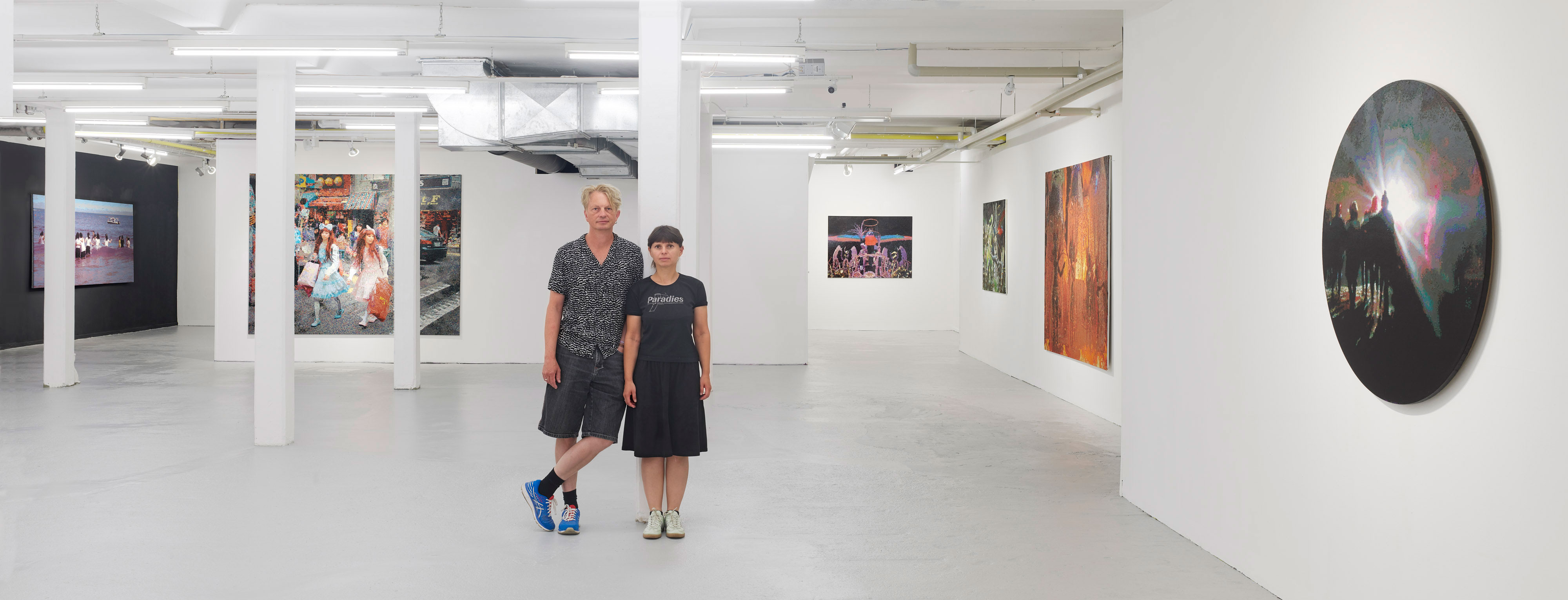- Dr. Anett Göthe „Radical Ritual“, 2020 русский
 Exhibition view with Römer + Römer, 2020
Exhibition view with Römer + Römer, 2020
Dr. Anett Göthe, Opening speech to the exhibition „Römer + Römer. Radical Ritual“ in the Lachenmann Art Gallery in Frankfurt/Main
The phrase „Getting to the point“ means to focus on something or to concentrate on the facts. By pinpointing a situation, correlations can be recognized and assessed in a better manner.
In the paintings of the Berlin-based artist couple Torsten and Nina Römer, also known as Römer + Römer, this saying is meant to be understood in the exact opposite way. Since their paintings are composed of many small, partly overlapping dots of color, in order to grasp the motifs and make an optical connection, one must let go, take a step back and observe the art piece as a whole. Only with increasing distance from the painting do the dots gradually form into pictorial subjects such as people, brightly colored lights and a festive atmosphere. However, the use of tiny dots of various pure colors blending and forming together in the viewer’s eye, is not an unknown phenomenon in art history. This referring to the Pointillist movement at the end of the 19th century, in which Post-Impressionist painters such as Georges Seurat – based on the color theory of the chemist Eugène Chevreul – dissolved the picture into individual color dots.
In this process, complementary contrasting colors are grouped next to each other, point by point, in such a way that, when the picture is viewed from a distance, they merge into one color, resulting in a more intense luminosity of the picture. This phenomenon of perception psychology also characterizes the working method of Römer + Römer, although the style of Pointillism and its underlying color theory is not the focus of the Berlin duo‘s artistic interest. Since their painting is based on the influence of photography, their work is oriented towards digital images and their dissolution into many individual shimmering pixels. Nina and Torsten Römer travel around the world pursuing their projects – always in search of suitable motifs to capture with their digital camera. At the end of each travel, their photographs serve as inspiration for their subsequent painting. Their works undergo a transformation: on the one hand, the level of artistic technique allows the paintings to undergo a change from photographic recording to processing in the form of the traditional medium with a sensual haptic touch. This in turn imagines a pixellation of digital images through the juxtaposition and superimposition of color dots. On the other hand, their works transform between the gestural and the figurative by means of a back and forth movement. Motifs that are characterized by bright colors and fascinating atmospheres are present, but the coarse resolution prevents a final recognition. Despite the obscurity and the enigmatic nature of the motifs, the viewer visually and intuitively perceives what is happening in the works of Römer + Römer. It is about people and situations that the two artists experience on their travels and capture in photographs.
Not recognizable at first sight, parallels can be seen between the works of Römer + Römer and the works of the Dutch painters of the Golden Age. Like Jan Vermeer van Delft, who was able to bring the invisible to light through the visible, the two Berlin artists also succeed in rendering the objects and people in their works the invisible through the visible: a symbolism and connection to life, a deeper meaning and everyday reality. Moreover, the working processes of the Berlin artists and the Dutch baroque painter also seem to have parallels. Just as Römer + Römer use digital photographs, we know today that Jan Vermeer van Delft also made use of the camera obscura in most of his pictures, in a way that does not negate the conditions of the photographic medium, but rather highlights them. Both the works of Römer + Römer and the works of Jan Vermeer van Delft exhibit an „abstract“ quality through this technical advance, in that they do not pretend to depict reality as it is, but as it is perceived.
Römer + Römer also process reality as they perceive it in the works in the exhibition „Radical Ritual“. On the basis of an extensive selection of works created in the course of their travels, they translate their impressions into a colorful, intoxicating display – from manga fans at Cosplay in Beijing to fantastically decorated samba dancers* in Rio de Janeiro to spectacular light installations and fantasy creatures of Fusion and the Burning Man Festival, which takes place every summer since 1990 for one week in the desert of the US state of Nevada. „Radical Ritual“ was also the title of the Burning-Man Festival in 2017, which Nina and Torsten Römer visited and which provided inspiration for most of the works shown in the exhibition. In partly largeformat works they capture the extraordinary atmosphere of this festival, which is characterized by colored light reflections and a strong light-dark contrast. In the depiction of nocturnal pictorial subjects, the desert landscape is transformed into a luminous artistic backdrop, illuminated by hundreds of light sources, installations and fires, which are expressed in the thousands of color dots in the works of Römer + Römer.
Dr. Anett Göthe, art historian
